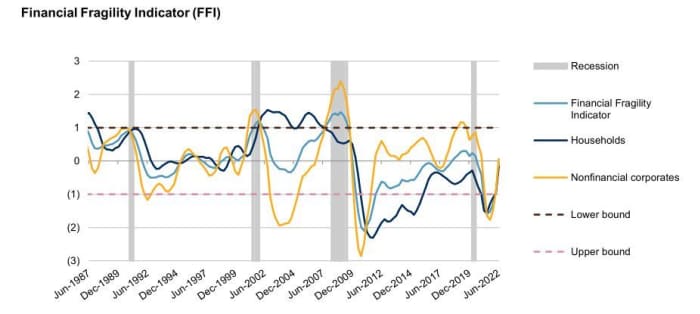After socking away savings during the aftermath of the COVID-19 crisis, American households and businesses are watching their financial cushions rapidly deteriorate as prices have soared and the Federal Reserve has substantially raised the cost of borrowing money.
That’s the takeaway from the latest reading of S&P Global Ratings’ Financial Fragility Indicator, which rose rapidly during the second quarter this year, marking the fastest pace of deterioration since the great financial crisis in 2008, and the dot-com crash back in 2001.
While the indicator has returned to its long-term average of zero, the pace of the move is much more alarming than the absolute level of the index, said Beth Ann Bovino, chief U.S. economist at S&P Global Ratings and the author of the report.
“What I find alarming is how quickly they sped through their savings,” Bovino said about American households and businesses during a phone conversation with MarketWatch.
“That doesn’t bode well for 2023, as the cumulative rate hikes take hold.”
The FFI is based in part on data about the financial accounts of U.S. consumers and businesses collected and published by the Federal Reserve. The higher the reading on the FFI, the less of a capital buffer available to help weather an unexpected expense.

S&P GLOBAL
Thanks to the lockdowns imposed during COVID-19, as well as the stimulus money doled out by the government to consumers and businesses in the wake of the crisis, consumers and businesses saw their savings buffers increase.
But now that trend is reversing rapidly, as capital buffers have nearly erased the entire post-pandemic rise.
During the first half of 2022, those savings were being unwound fairly rapidly, thanks in part to impact of inflation, which rose to its highest level in more than 40 years over the summer.
It’s quite possible that the indicator could reach levels associated with severe economic stress as soon as next year, Bovino said.
American consumers and businesses are still waiting to see the full impact of the Federal Reserve’s jumbo interest-rate hikes feed through to the broader economy.
But as borrowing costs continue to rise and prices remain stubbornly high, Bovino expects these signs of stress to worsen heading into 2023.
Perhaps the only thing that might avert a crisis would be a pivot in policy from the Federal Reserve. Although Federal Reserve Chairman Jerome Powell has said he would keep interest rates high until inflation finally wanes.
“We believe this negative loop of tighter financial conditions can ultimately only be broken by the Federal Reserve,” said a team of global markets analysts at MFUG Bank in a note to clients.
Source: https://www.marketwatch.com/story/american-households-and-businesses-are-seeing-their-savings-deteriorate-as-financial-fragility-rises-11665001083?siteid=yhoof2&yptr=yahoo